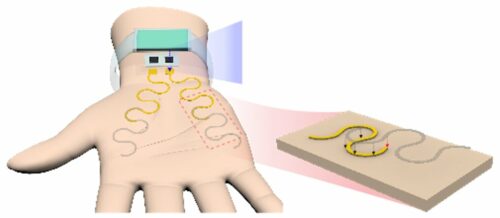Researchers have developed an electronic tattoo to measure and track human emotions like excitement and stress.

For decades, doctors have placed electrodes on the body to read electrical signals from the brain and heart. Electronic devices that tell us about our health, such as blood pressure monitors, are commonly used at the doctor’s office.
Researchers at the University of Texas at Austin have developed a temporary “e-tattoo” for the palm that can track excitement and stress using the skin’s electrical conductivity. The e-tattoo could be a reliable way for people with conditions such as anxiety or depression to track their emotions.
When we experience strong emotions such as excitement and stress, our eccrine sweat glands fill up, making our skin more electrically conductive. Smart watches can contain wrist sensors that measure skin conductivity to track stress levels. The palm is an area of the body that contains the highest concentration of eccrine sweat glands. Researchers believe that an electronic tattoo for the palm would give the wearer more accurate stress readings than a smart watch but the tattoo would need to stay on one of the most active parts of the body, which is the palm as well.
At the current stage, scientists collect eccrine sweat gland data from the palm by attaching gel electrodes with dangling wires that connect to a wristwatch. Gel electrodes are stiff and bulky and can fall off during everyday activities, Lu said.
Nanshu Lu, a professor at the University of Texas at Austin’s Cockrell School of Engineering and her team also created two S-shaped gold ribbons that snake across the palm and connect the palm tattoo to a wristwatch. The wristwatch wirelessly sends the data to a smartphone, where the wearer can read it. The gold ribbons are extremely thin, just 750 nanometers thick. A sheet of paper, for reference, is about 100,000 nanometers thick.
Researchers tested the e-tattoo which confirmed similar readings to the gel electrodes. Then they attached two identical watches to the wrists of two people. One watch was connected to gel electrodes on the palm. The other was connected to the ultrathin gold ribbons and the e-tattoo. They collected data for 15 hours while the people went through everyday motions like studying, eating, exercising and sleeping. The gel electrodes fell off three to five times over the 15 hours. The e-tattoo didn’t fall off.
Reference : Hongwoo Jang et al, Graphene e-tattoos for unobstructive ambulatory electrodermal activity sensing on the palm enabled by heterogeneous serpentine ribbons, Nature Communications (2022). DOI: 10.1038/s41467-022-34406-2






